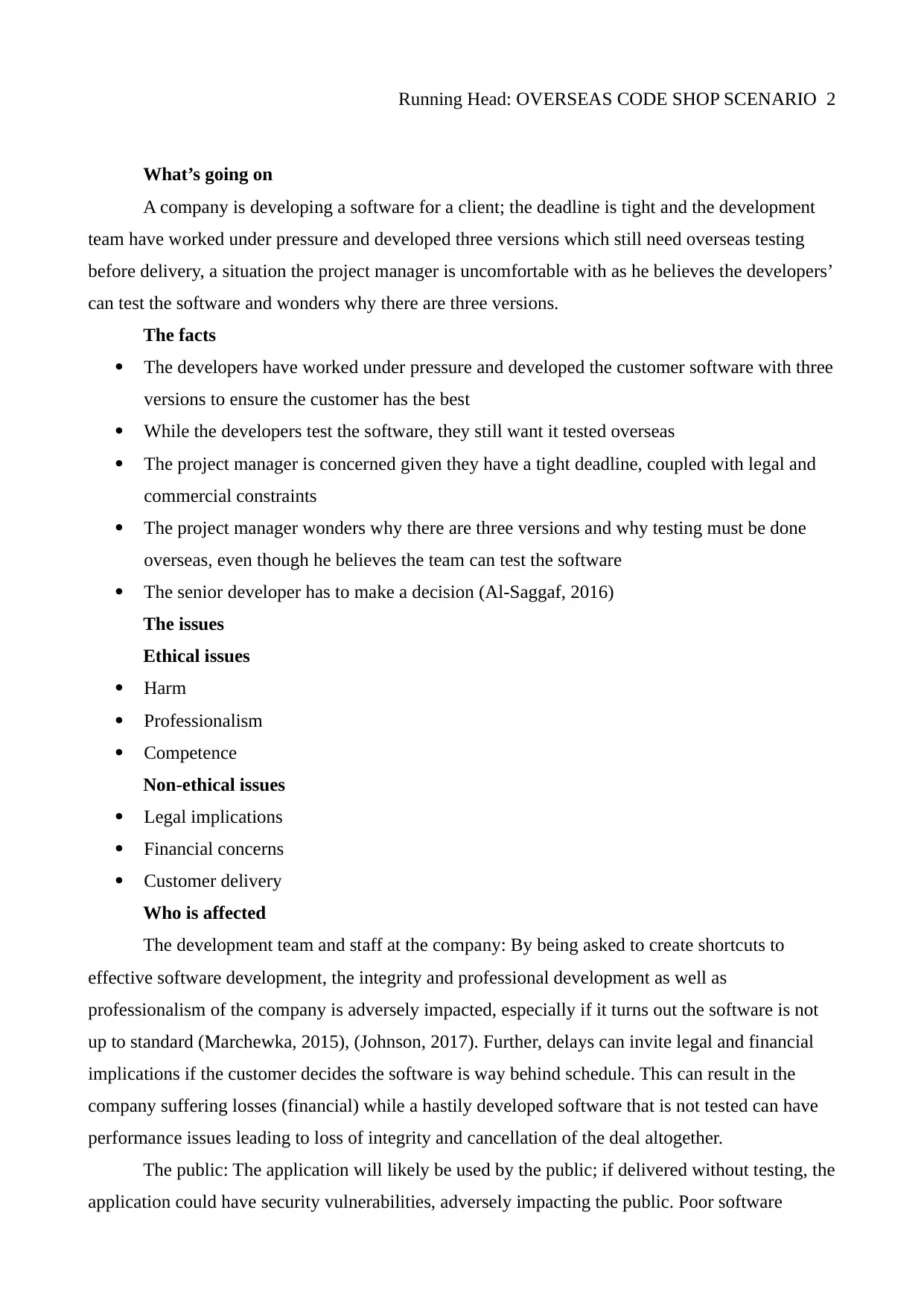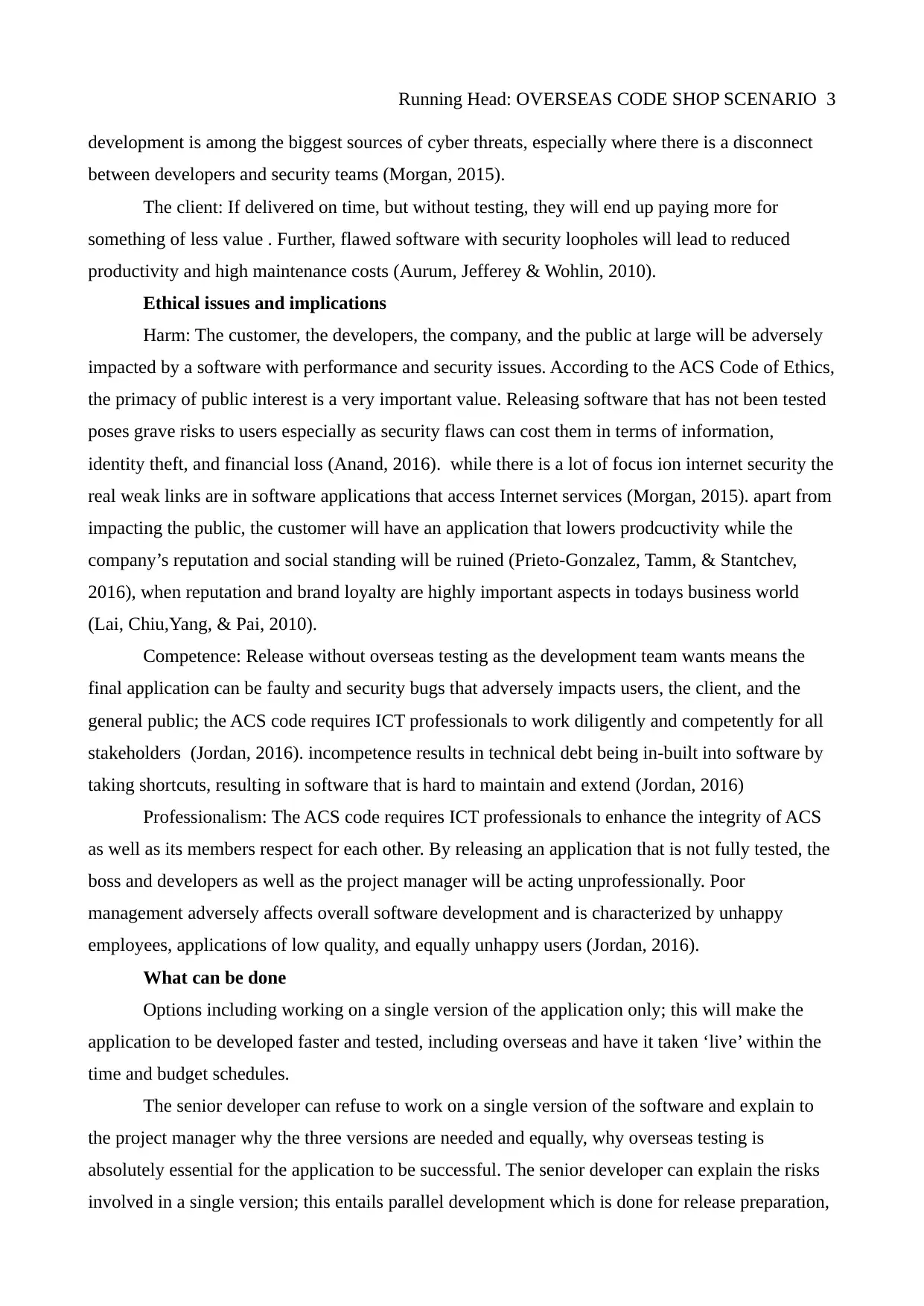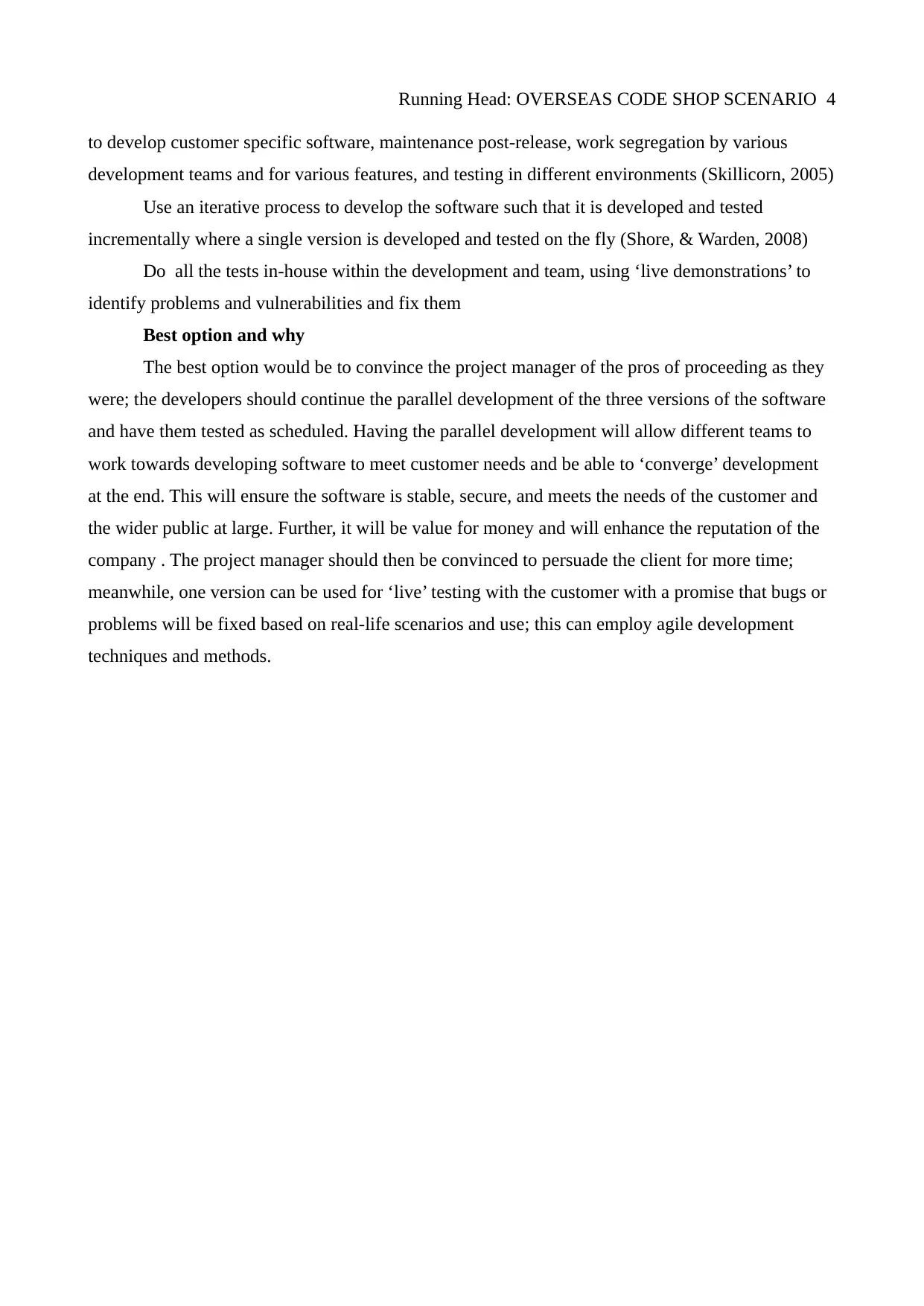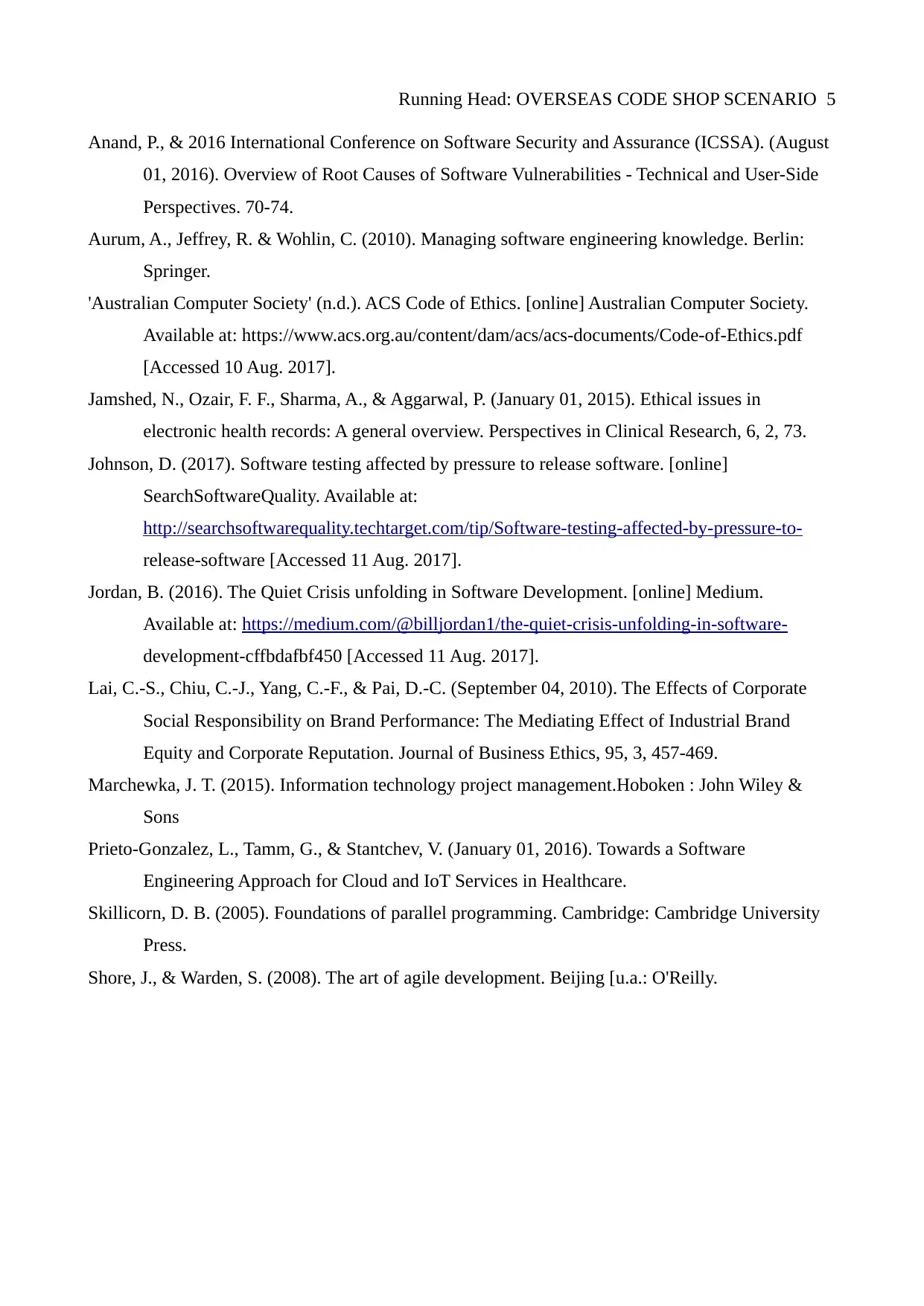Overseas Code Shop Case Study: Software Development Issues
VerifiedAdded on 2020/03/04
|5
|1486
|55
Case Study
AI Summary
This case study, titled "Overseas Code Shop," presents a scenario involving a software development company facing tight deadlines and pressure to deliver a product. The development team has created three versions of the software, but the project manager is hesitant about the need for overseas testing, despite the developers' belief in its necessity. The case explores ethical issues such as harm, competence, and professionalism, impacting the development team, the client, and the public. Potential non-ethical issues, including legal and financial implications, are also discussed. The analysis considers various options, including developing a single version, justifying the need for multiple versions and overseas testing, and using iterative or agile development processes. The best solution involves convincing the project manager to allow the developers to proceed with their parallel development and overseas testing plans, potentially involving the client in live testing. The case emphasizes the importance of software quality, security, and ethical conduct in software development projects.

Running Head: OVERSEAS CODE SHOP SCENARIO 1
Overseas Code Shop Scenario
Name
Date
(Words 961)
Overseas Code Shop Scenario
Name
Date
(Words 961)
Paraphrase This Document
Need a fresh take? Get an instant paraphrase of this document with our AI Paraphraser

Running Head: OVERSEAS CODE SHOP SCENARIO 2
What’s going on
A company is developing a software for a client; the deadline is tight and the development
team have worked under pressure and developed three versions which still need overseas testing
before delivery, a situation the project manager is uncomfortable with as he believes the developers’
can test the software and wonders why there are three versions.
The facts
The developers have worked under pressure and developed the customer software with three
versions to ensure the customer has the best
While the developers test the software, they still want it tested overseas
The project manager is concerned given they have a tight deadline, coupled with legal and
commercial constraints
The project manager wonders why there are three versions and why testing must be done
overseas, even though he believes the team can test the software
The senior developer has to make a decision (Al-Saggaf, 2016)
The issues
Ethical issues
Harm
Professionalism
Competence
Non-ethical issues
Legal implications
Financial concerns
Customer delivery
Who is affected
The development team and staff at the company: By being asked to create shortcuts to
effective software development, the integrity and professional development as well as
professionalism of the company is adversely impacted, especially if it turns out the software is not
up to standard (Marchewka, 2015), (Johnson, 2017). Further, delays can invite legal and financial
implications if the customer decides the software is way behind schedule. This can result in the
company suffering losses (financial) while a hastily developed software that is not tested can have
performance issues leading to loss of integrity and cancellation of the deal altogether.
The public: The application will likely be used by the public; if delivered without testing, the
application could have security vulnerabilities, adversely impacting the public. Poor software
What’s going on
A company is developing a software for a client; the deadline is tight and the development
team have worked under pressure and developed three versions which still need overseas testing
before delivery, a situation the project manager is uncomfortable with as he believes the developers’
can test the software and wonders why there are three versions.
The facts
The developers have worked under pressure and developed the customer software with three
versions to ensure the customer has the best
While the developers test the software, they still want it tested overseas
The project manager is concerned given they have a tight deadline, coupled with legal and
commercial constraints
The project manager wonders why there are three versions and why testing must be done
overseas, even though he believes the team can test the software
The senior developer has to make a decision (Al-Saggaf, 2016)
The issues
Ethical issues
Harm
Professionalism
Competence
Non-ethical issues
Legal implications
Financial concerns
Customer delivery
Who is affected
The development team and staff at the company: By being asked to create shortcuts to
effective software development, the integrity and professional development as well as
professionalism of the company is adversely impacted, especially if it turns out the software is not
up to standard (Marchewka, 2015), (Johnson, 2017). Further, delays can invite legal and financial
implications if the customer decides the software is way behind schedule. This can result in the
company suffering losses (financial) while a hastily developed software that is not tested can have
performance issues leading to loss of integrity and cancellation of the deal altogether.
The public: The application will likely be used by the public; if delivered without testing, the
application could have security vulnerabilities, adversely impacting the public. Poor software

Running Head: OVERSEAS CODE SHOP SCENARIO 3
development is among the biggest sources of cyber threats, especially where there is a disconnect
between developers and security teams (Morgan, 2015).
The client: If delivered on time, but without testing, they will end up paying more for
something of less value . Further, flawed software with security loopholes will lead to reduced
productivity and high maintenance costs (Aurum, Jefferey & Wohlin, 2010).
Ethical issues and implications
Harm: The customer, the developers, the company, and the public at large will be adversely
impacted by a software with performance and security issues. According to the ACS Code of Ethics,
the primacy of public interest is a very important value. Releasing software that has not been tested
poses grave risks to users especially as security flaws can cost them in terms of information,
identity theft, and financial loss (Anand, 2016). while there is a lot of focus ion internet security the
real weak links are in software applications that access Internet services (Morgan, 2015). apart from
impacting the public, the customer will have an application that lowers prodcuctivity while the
company’s reputation and social standing will be ruined (Prieto-Gonzalez, Tamm, & Stantchev,
2016), when reputation and brand loyalty are highly important aspects in todays business world
(Lai, Chiu,Yang, & Pai, 2010).
Competence: Release without overseas testing as the development team wants means the
final application can be faulty and security bugs that adversely impacts users, the client, and the
general public; the ACS code requires ICT professionals to work diligently and competently for all
stakeholders (Jordan, 2016). incompetence results in technical debt being in-built into software by
taking shortcuts, resulting in software that is hard to maintain and extend (Jordan, 2016)
Professionalism: The ACS code requires ICT professionals to enhance the integrity of ACS
as well as its members respect for each other. By releasing an application that is not fully tested, the
boss and developers as well as the project manager will be acting unprofessionally. Poor
management adversely affects overall software development and is characterized by unhappy
employees, applications of low quality, and equally unhappy users (Jordan, 2016).
What can be done
Options including working on a single version of the application only; this will make the
application to be developed faster and tested, including overseas and have it taken ‘live’ within the
time and budget schedules.
The senior developer can refuse to work on a single version of the software and explain to
the project manager why the three versions are needed and equally, why overseas testing is
absolutely essential for the application to be successful. The senior developer can explain the risks
involved in a single version; this entails parallel development which is done for release preparation,
development is among the biggest sources of cyber threats, especially where there is a disconnect
between developers and security teams (Morgan, 2015).
The client: If delivered on time, but without testing, they will end up paying more for
something of less value . Further, flawed software with security loopholes will lead to reduced
productivity and high maintenance costs (Aurum, Jefferey & Wohlin, 2010).
Ethical issues and implications
Harm: The customer, the developers, the company, and the public at large will be adversely
impacted by a software with performance and security issues. According to the ACS Code of Ethics,
the primacy of public interest is a very important value. Releasing software that has not been tested
poses grave risks to users especially as security flaws can cost them in terms of information,
identity theft, and financial loss (Anand, 2016). while there is a lot of focus ion internet security the
real weak links are in software applications that access Internet services (Morgan, 2015). apart from
impacting the public, the customer will have an application that lowers prodcuctivity while the
company’s reputation and social standing will be ruined (Prieto-Gonzalez, Tamm, & Stantchev,
2016), when reputation and brand loyalty are highly important aspects in todays business world
(Lai, Chiu,Yang, & Pai, 2010).
Competence: Release without overseas testing as the development team wants means the
final application can be faulty and security bugs that adversely impacts users, the client, and the
general public; the ACS code requires ICT professionals to work diligently and competently for all
stakeholders (Jordan, 2016). incompetence results in technical debt being in-built into software by
taking shortcuts, resulting in software that is hard to maintain and extend (Jordan, 2016)
Professionalism: The ACS code requires ICT professionals to enhance the integrity of ACS
as well as its members respect for each other. By releasing an application that is not fully tested, the
boss and developers as well as the project manager will be acting unprofessionally. Poor
management adversely affects overall software development and is characterized by unhappy
employees, applications of low quality, and equally unhappy users (Jordan, 2016).
What can be done
Options including working on a single version of the application only; this will make the
application to be developed faster and tested, including overseas and have it taken ‘live’ within the
time and budget schedules.
The senior developer can refuse to work on a single version of the software and explain to
the project manager why the three versions are needed and equally, why overseas testing is
absolutely essential for the application to be successful. The senior developer can explain the risks
involved in a single version; this entails parallel development which is done for release preparation,
⊘ This is a preview!⊘
Do you want full access?
Subscribe today to unlock all pages.

Trusted by 1+ million students worldwide

Running Head: OVERSEAS CODE SHOP SCENARIO 4
to develop customer specific software, maintenance post-release, work segregation by various
development teams and for various features, and testing in different environments (Skillicorn, 2005)
Use an iterative process to develop the software such that it is developed and tested
incrementally where a single version is developed and tested on the fly (Shore, & Warden, 2008)
Do all the tests in-house within the development and team, using ‘live demonstrations’ to
identify problems and vulnerabilities and fix them
Best option and why
The best option would be to convince the project manager of the pros of proceeding as they
were; the developers should continue the parallel development of the three versions of the software
and have them tested as scheduled. Having the parallel development will allow different teams to
work towards developing software to meet customer needs and be able to ‘converge’ development
at the end. This will ensure the software is stable, secure, and meets the needs of the customer and
the wider public at large. Further, it will be value for money and will enhance the reputation of the
company . The project manager should then be convinced to persuade the client for more time;
meanwhile, one version can be used for ‘live’ testing with the customer with a promise that bugs or
problems will be fixed based on real-life scenarios and use; this can employ agile development
techniques and methods.
to develop customer specific software, maintenance post-release, work segregation by various
development teams and for various features, and testing in different environments (Skillicorn, 2005)
Use an iterative process to develop the software such that it is developed and tested
incrementally where a single version is developed and tested on the fly (Shore, & Warden, 2008)
Do all the tests in-house within the development and team, using ‘live demonstrations’ to
identify problems and vulnerabilities and fix them
Best option and why
The best option would be to convince the project manager of the pros of proceeding as they
were; the developers should continue the parallel development of the three versions of the software
and have them tested as scheduled. Having the parallel development will allow different teams to
work towards developing software to meet customer needs and be able to ‘converge’ development
at the end. This will ensure the software is stable, secure, and meets the needs of the customer and
the wider public at large. Further, it will be value for money and will enhance the reputation of the
company . The project manager should then be convinced to persuade the client for more time;
meanwhile, one version can be used for ‘live’ testing with the customer with a promise that bugs or
problems will be fixed based on real-life scenarios and use; this can employ agile development
techniques and methods.
Paraphrase This Document
Need a fresh take? Get an instant paraphrase of this document with our AI Paraphraser

Running Head: OVERSEAS CODE SHOP SCENARIO 5
Anand, P., & 2016 International Conference on Software Security and Assurance (ICSSA). (August
01, 2016). Overview of Root Causes of Software Vulnerabilities - Technical and User-Side
Perspectives. 70-74.
Aurum, A., Jeffrey, R. & Wohlin, C. (2010). Managing software engineering knowledge. Berlin:
Springer.
'Australian Computer Society' (n.d.). ACS Code of Ethics. [online] Australian Computer Society.
Available at: https://www.acs.org.au/content/dam/acs/acs-documents/Code-of-Ethics.pdf
[Accessed 10 Aug. 2017].
Jamshed, N., Ozair, F. F., Sharma, A., & Aggarwal, P. (January 01, 2015). Ethical issues in
electronic health records: A general overview. Perspectives in Clinical Research, 6, 2, 73.
Johnson, D. (2017). Software testing affected by pressure to release software. [online]
SearchSoftwareQuality. Available at:
http://searchsoftwarequality.techtarget.com/tip/Software-testing-affected-by-pressure-to-
release-software [Accessed 11 Aug. 2017].
Jordan, B. (2016). The Quiet Crisis unfolding in Software Development. [online] Medium.
Available at: https://medium.com/@billjordan1/the-quiet-crisis-unfolding-in-software-
development-cffbdafbf450 [Accessed 11 Aug. 2017].
Lai, C.-S., Chiu, C.-J., Yang, C.-F., & Pai, D.-C. (September 04, 2010). The Effects of Corporate
Social Responsibility on Brand Performance: The Mediating Effect of Industrial Brand
Equity and Corporate Reputation. Journal of Business Ethics, 95, 3, 457-469.
Marchewka, J. T. (2015). Information technology project management.Hoboken : John Wiley &
Sons
Prieto-Gonzalez, L., Tamm, G., & Stantchev, V. (January 01, 2016). Towards a Software
Engineering Approach for Cloud and IoT Services in Healthcare.
Skillicorn, D. B. (2005). Foundations of parallel programming. Cambridge: Cambridge University
Press.
Shore, J., & Warden, S. (2008). The art of agile development. Beijing [u.a.: O'Reilly.
Anand, P., & 2016 International Conference on Software Security and Assurance (ICSSA). (August
01, 2016). Overview of Root Causes of Software Vulnerabilities - Technical and User-Side
Perspectives. 70-74.
Aurum, A., Jeffrey, R. & Wohlin, C. (2010). Managing software engineering knowledge. Berlin:
Springer.
'Australian Computer Society' (n.d.). ACS Code of Ethics. [online] Australian Computer Society.
Available at: https://www.acs.org.au/content/dam/acs/acs-documents/Code-of-Ethics.pdf
[Accessed 10 Aug. 2017].
Jamshed, N., Ozair, F. F., Sharma, A., & Aggarwal, P. (January 01, 2015). Ethical issues in
electronic health records: A general overview. Perspectives in Clinical Research, 6, 2, 73.
Johnson, D. (2017). Software testing affected by pressure to release software. [online]
SearchSoftwareQuality. Available at:
http://searchsoftwarequality.techtarget.com/tip/Software-testing-affected-by-pressure-to-
release-software [Accessed 11 Aug. 2017].
Jordan, B. (2016). The Quiet Crisis unfolding in Software Development. [online] Medium.
Available at: https://medium.com/@billjordan1/the-quiet-crisis-unfolding-in-software-
development-cffbdafbf450 [Accessed 11 Aug. 2017].
Lai, C.-S., Chiu, C.-J., Yang, C.-F., & Pai, D.-C. (September 04, 2010). The Effects of Corporate
Social Responsibility on Brand Performance: The Mediating Effect of Industrial Brand
Equity and Corporate Reputation. Journal of Business Ethics, 95, 3, 457-469.
Marchewka, J. T. (2015). Information technology project management.Hoboken : John Wiley &
Sons
Prieto-Gonzalez, L., Tamm, G., & Stantchev, V. (January 01, 2016). Towards a Software
Engineering Approach for Cloud and IoT Services in Healthcare.
Skillicorn, D. B. (2005). Foundations of parallel programming. Cambridge: Cambridge University
Press.
Shore, J., & Warden, S. (2008). The art of agile development. Beijing [u.a.: O'Reilly.
1 out of 5
Related Documents
Your All-in-One AI-Powered Toolkit for Academic Success.
+13062052269
info@desklib.com
Available 24*7 on WhatsApp / Email
![[object Object]](/_next/static/media/star-bottom.7253800d.svg)
Unlock your academic potential
Copyright © 2020–2025 A2Z Services. All Rights Reserved. Developed and managed by ZUCOL.





